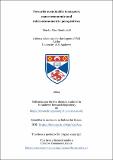Files in this item
Towards sustainable transport : macroeconomic and microeconometric perspectives
Item metadata
| dc.contributor.advisor | Jaeger, David A. | |
| dc.contributor.advisor | Stefanski, Radoslaw (Radek) | |
| dc.contributor.author | Mac Domhnaill, Ciarán | |
| dc.coverage.spatial | 302 | en_US |
| dc.date.accessioned | 2024-03-20T16:17:59Z | |
| dc.date.available | 2024-03-20T16:17:59Z | |
| dc.date.issued | 2024-06-13 | |
| dc.identifier.uri | https://hdl.handle.net/10023/29535 | |
| dc.description.abstract | Progressing towards sustainable transport will be critical to meeting the Paris Climate Change Agreement's target of limiting the global temperature rise to 1.5 degrees Celsius. This thesis explores questions relevant to this transition. Have we reached 'peak car'? Did Brexit cause a shift from road freight transport to the more energy efficient mode of short sea shipping? Can ride hailing platforms advance transport sustainability? In Chapter 1, using 1950-2010 data on 88 countries, I demonstrate that the number of private cars per GDP in the economy, or 'car intensity', evolves in a hump-shaped pattern during economic development. I develop a general equilibrium model to argue that structural transformation can generate this trend. My calibrated model can account for a quarter of observed variation in car intensity among 54 countries in 2010. Counterfactual exercises show that peak intensity is lower for economies that develop later. In Chapter 2, I conduct a difference-in-differences analysis of the effect of Brexit on maritime cargo volumes. I examine 2013-2022 Eurostat port-level data and find a 22 per cent decrease in EU-UK roll-on roll-off (Ro-Ro) volumes, and a 54 per cent decrease in Ireland-UK Ro-Ro volumes, due to Brexit. I find a concurrent increase of 147 per cent in Ireland-France Ro-Ro cargo, indicating a diversion from the UK land-bridge route to direct short sea shipping routes. I estimate that emissions would be roughly 60 per cent lower on the direct route. In Chapter 3, I employ Scottish Household Survey 2012-2019 travel diary data from 16,712 individuals in a difference-in-differences examination of how ride hailing affected the use of other transport modes. Results reveal a small complementary effect on the use of public transport relative to driving a car in Glasgow, which is more pronounced among individuals who are younger, male, and with higher household income. | en_US |
| dc.language.iso | en | en_US |
| dc.rights | Creative Commons Attribution-NonCommercial-NoDerivatives 4.0 International | * |
| dc.rights.uri | http://creativecommons.org/licenses/by-nc-nd/4.0/ | * |
| dc.subject | Transport | en_US |
| dc.subject | Sustainable transport | en_US |
| dc.subject | Peak car | en_US |
| dc.subject | Structural transformation | en_US |
| dc.subject | Economic growth | en_US |
| dc.subject | Industrialisation | en_US |
| dc.subject | Ride hailing | en_US |
| dc.subject | Free trade agreements | en_US |
| dc.subject | Brexit | en_US |
| dc.title | Towards sustainable transport : macroeconomic and microeconometric perspectives | en_US |
| dc.type | Thesis | en_US |
| dc.contributor.sponsor | University of St Andrews. Handsel Scholarship Scheme | en_US |
| dc.type.qualificationlevel | Doctoral | en_US |
| dc.type.qualificationname | PhD Doctor of Philosophy | en_US |
| dc.publisher.institution | The University of St Andrews | en_US |
| dc.identifier.doi | https://doi.org/10.17630/sta/829 |
The following licence files are associated with this item:
This item appears in the following Collection(s)
Except where otherwise noted within the work, this item's licence for re-use is described as Creative Commons Attribution-NonCommercial-NoDerivatives 4.0 International
Items in the St Andrews Research Repository are protected by copyright, with all rights reserved, unless otherwise indicated.


